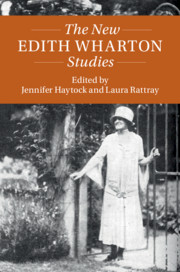Book contents
- The New Edith Wharton Studies
- Twenty-First-Century Critical Revisions
- The New Edith Wharton Studies
- Copyright page
- Contents
- Notes on Contributors
- Acknowledgments
- Editions and Abbreviations
- Introduction
- Part I Self and Composition
- Part II International Wharton
- Part III Wharton on the Margins
- Part IV Sex and Gender Revisited
- Chapter 11 Women, Art, and the Natural World in Edith Wharton’s Works
- Chapter 12 Wharton and the Romance Plot
- Chapter 13 Masculine Modernity: Fathers, Sons, and Generational Absolution in Wharton’s Fiction
- Chapter 14 Wharton’s Wayward Girls
- Bibliography
- Index
Chapter 14 - Wharton’s Wayward Girls
from Part IV - Sex and Gender Revisited
Published online by Cambridge University Press: 28 November 2019
- The New Edith Wharton Studies
- Twenty-First-Century Critical Revisions
- The New Edith Wharton Studies
- Copyright page
- Contents
- Notes on Contributors
- Acknowledgments
- Editions and Abbreviations
- Introduction
- Part I Self and Composition
- Part II International Wharton
- Part III Wharton on the Margins
- Part IV Sex and Gender Revisited
- Chapter 11 Women, Art, and the Natural World in Edith Wharton’s Works
- Chapter 12 Wharton and the Romance Plot
- Chapter 13 Masculine Modernity: Fathers, Sons, and Generational Absolution in Wharton’s Fiction
- Chapter 14 Wharton’s Wayward Girls
- Bibliography
- Index
Summary
Critics have tended to dismiss Wharton’s depictions of children as victims of their parents’ misbehavior (Paul Marvell of The Custom of the Country) to optimistic symbols of the future (Nettie Struther’s baby in The House of Mirth), failing to take into account the complexity of children as characters. In fact, Wharton’s novels are populated with children – typically girls – marked by suggestions of gender queerness; transgression, seduction, and aggression; age-impropriety; and ethnic ambiguity. From “The Valley of Childish Things” (1896) to “A Little Girl’s New York” (1938), Wharton emphasizes the absence of childhood innocence and the resistance of children to linear development. Wharton’s children are rarely innocent, frequently knowing, and resistant to narratives of linear development. Concentrating on the novels The Reef (1912) and The Children (1928), and touching on other works by Wharton, I demonstrate how this theme flows throughout the author’s corpus.
Keywords
- Type
- Chapter
- Information
- The New Edith Wharton Studies , pp. 217 - 230Publisher: Cambridge University PressPrint publication year: 2019
- 1
- Cited by



